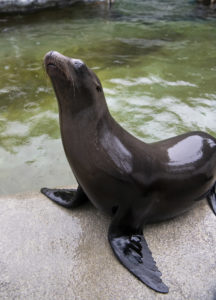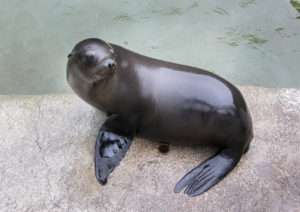Two orphaned California sea lions have splashed into the Rocky Shores pools at Point Defiance Zoo & Aquarium, taking the zoo’s total sea lion count to five.
Eloise and Boomer arrived last week accompanied by zoo veterinarian Dr. Kadie Anderson and staff biologist Sheriden Ploof. Born last summer, the pups have been cared for by SeaWorld, San Diego staff, and are now thriving.
With sleek dark fur and irrepressible energy, the two sea lions immediately settled into their new home. They will make their public debut together July 26.
“We’re so pleased that we can give a home to these young sea lions,” said Malia Somerville, the zoo’s curator of marine mammals and birds. “As orphans, they both had a rough start in life, and would not have survived without expert human care. Now they can be ambassadors, inspiring us all to protect wildlife.”
Rescued as orphans

Eloise, the smaller of the two, was spotted all alone in June 2018 at La Jolla Cove Beach in California. After watching for 48 hours, the rescue team determined that she had been abandoned, and took her to be cared for a SeaWorld. Although dehydrated, she recovered well, suckling from a bottle and later eating fish. She now weighs 64 pounds, and is the bolder of the two, eagerly exploring the pools behind the scenes at Point Defiance Zoo & Aquarium.
Boomer, slightly larger, was rescued as a pup in July 2018 from the Tijuana Slough National Wildlife Refuge at Imperial Beach, California. Alone on the beach, he was handled and touched by humans, an action that can cause adult sea lions – who may in fact be returning – to abandon their pups. When the rescue team arrived, he was dehydrated, lethargic and shivering. At SeaWorld the care team rehabilitated the pup, tube-feeding him until he was strong enough to eat fish. Boomer now weighs 84 pounds and loves his fish, swimming side by side with Eloise.

“They’re very healthy sea lions,” said Anderson. “While they are much smaller than other sea lions their age, due to their difficult first months, they are thriving now.”
The two new arrivals bring the
zoo’s sea lion count to five. Already living at Point Defiance Zoo were females Neah and Matia, born to rescued mothers in 2004, and Chinook, a male who was relocated from the Bonneville Dam in 2016 as part of a state effort to protect salmon in the Columbia River.
While Eloise and Boomer can see the other sea lions through the pools’ windows, they will stay separate until they have adjusted to their new home, says Somerville. Eventually some of the five may share space.
“Sea lions are social animals,” Somerville explained. “They live in huge colonies in the wild. Ours are very curious about each other, but we need them to be comfortable to take the best care of them.”
California sea lions are prolific along the West Coast, gathering on rocky shores for breeding. Their diet includes rockfish, salmon, anchovies, krill and squid, and they are in turn hunted by sharks and orcas. Excellent swimmers, they can hit speeds of up to 25 miles per hour underwater, and can dive for nearly 10 minutes without needing a breath.
Sea lions are also noisy, as Zoo guests can attest: They growl, roar and bark to warn intruders or attract mates, and mothers have special calls to identify pups for feeding.
While sea lions are not a threatened species in the wild, they are affected, like all marine mammals, from human-caused pollution such as oil spills, toxic chemicals and plastic debris, as well as human harassment.